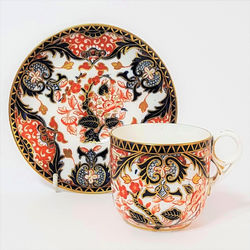
Royal Crown Derby
 |  |  |
|---|---|---|
 |  |
View our selection of Royal Crown Derby - Shop by Maker "Royal Crown Derby" in Ceramics
The Royal Crown Derby Porcelain Company is one of the oldest remaining English porcelain manufacturers. Known for its high-quality bone china, it has produced tableware and ornamental items since c1750. The company was known as Derby Porcelain until 1775, when King George III granted the factory the honour of being able to incorporate a crown into its backstamp - becoming Crown Derby. In 1890, Queen Victoria awarded Crown Derby the royal warrant and the company was renamed Royal Crown Derby.

Painted marks 1784-1825
It started with Andrew Planche (a Huguenot who had settled from Saxony) who established the first china-works in Derby prior to 1750. The Derby company was subsequently established (in Cockpit Hill) c1756 by Andrew Planche, William Duesbury (a porcelain painter formerly at the Chelsea porcelain factory) and the banker John Heath. Planche dropped out of the partnership leaving Duesbury and Heath, and later Duesbury alone to develop the business.
He achieved this by the acquisition of the famous Chelsea porcelain factory in London. He operated it on its original site until 1784 when he demolished the buildings and transferred stock, patterns and moulds along with many of the workmen, to Derby. In 1776, he also acquired the remainder of the formerly prestigious Bow porcelain factory. When William Duesbury died in 1797 many of his team left the factory which led to a decline in the fortunes of Crown Derby.
Duesbury developed a new body which enabled then to produce high quality tableware and, employing the best available talents, established Derby as a leading manufacturer of dinner services and figurines. In 1770, Duesbury further increased the already high reputation of Derby.
It was Robert Bloor who restored the Derby porcelain reputation when he took control of the factory in 1811 and began to build a team of fine painters. Rich and elegant services were produced at this time and shapes tended to be larger and more flamboyant. Also typical of the period are the lavishly decorated Japan or Imari patterns.
In 1845, however, Bloor died, and after three years under Thomas Clarke, the Cockpit Works were sold and the factory closed in 1848. This might have been the end of Derby except for a group of former employees who set up a small works in King Street, Derby - continuing to use the moulds, patterns and trademarks of the former business. At the King Street works wares were thrown and no mechanical aids were used in decorating - so no two pieces were exactly alike. Crown Derby's reputation continued to thrive and in 1877 a new factory at Osmaston Road was opened - the site of Royal Crown Derby today. Crown Derby’s patterns became immensely popular during the late Victorian period, as their romantic and lavish designs met the popular taste of the period.
.jpg)
Detail of Royal Crown Derby's Imari Kings or Old Japan pattern
![Example of Derby soft-paste porcelain dish c1755. [© Victoria and Albert Museum, London]](https://static.wixstatic.com/media/ec5a46_6d44e584d9e94c6392e3ba2ba3fc25f4~mv2.jpg/v1/fill/w_316,h_231,al_c,lg_1,q_80,enc_avif,quality_auto/ec5a46_6d44e584d9e94c6392e3ba2ba3fc25f4~mv2.jpg)
Example of Derby soft-paste porcelain dish c1755. [© Victoria and Albert Museum, London]
![Toilet bottle c1773 - likely made Derby, decorated Chelsea. [© Victoria and Albert Museum, London]](https://static.wixstatic.com/media/ec5a46_51e853ef5e304391bf7116c36f6337f2~mv2.jpg/v1/fill/w_230,h_320,al_c,lg_1,q_80,enc_avif,quality_auto/ec5a46_51e853ef5e304391bf7116c36f6337f2~mv2.jpg)
Toilet bottle c1773 - likely made Derby, decorated Chelsea. [© Victoria and Albert Museum, London]
We have only included a brief overview of Derby's history here. For further information Royal Crown Derby has a very comprehensive account of their history, as has The Pottery Histories.